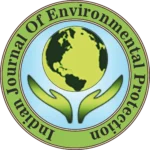IJEP 41(1): 3-10 : Vol. 41 Issue. 1 (January 2021)
Shailja Singh 1, Vishal Singh Chowdhary1, Devendra Pratap Singh1, Shiv Shankar2 and Shikha1
1. Babasaheb Bhimrao Ambedkar University, Department of Environmental Science, School of Earth and Environ mental Sciences, Lucknow – 226 025, U.P., India
2. Gautam Buddha University, Department of Environmental Science, School of Vocational Studies and Applied Sciences, Gautam Buddh Nagar – 201 312, U.P., India
Abstract
Indiscriminate use and inertness of synthetic polymers leading to increased water and land pollution are of great concern. Many attempts have been made to control the problem by using both chemical and biological methods. Chemical methods resulted in an increase in pollution by releasing noxious gases in the atmosphere whereas biological methods have been proved to be eco-friendly. The current study demonstrates the isolation, characterization and biodegradation analysis of the low-density polyethylene (LDPE) films by the isolated bacteria. Various techniques were used to determine the changes induced in the polyethylene sheet after treatment with bacteria. Gradual reduction, in the weight of degraded LDPE with time, signifies the utilization of polymer by bacteria for nutrients and energy. Analysis through scanning electron microscopy (SEM) of the degraded LDPE films showed morphological damage, like cracks, extensive roughening, fragileness and fragmentations on the surface of the LDPE sheets confirming that degradation had occurred by the action of bacterial isolates. Fourier transform infrared spectroscopy (FTIR) analysis of the degraded LDPE films, showed the presence of alcohols, alkenes, alkanes, amines being produced after 90 days, indicating that degradation had been carried out successfully. Energy dispersive x-ray study revealed the decrease in carbon content which shows that the carbon has been utilized by bacteria for their growth. Hence, the two potential bacterial strains isolated in the present study can be said to be plastic degrading microorganisms.
Keywords
Low-density polyethylene, Scanning electron microscopy, Fourier transforms spectroscopy, Biodegradation, Pollution
References
- Browne, M.A., et al. 2008. Ingested microscopic plastic translocates to the circulatory system of the mussel, Mytilus edulis (L.). Env. Sci. Tech., 42(13): 5026-5031.
- Avio, C.G., S. Gorbi and F. Regoli. 2015. Experimental development of a new protocol for extraction and characterization of microplastics in fish tissues: First observations in commercial species from Adriatic sea. Marine Env. Res., 111: 18-26.
- Hakkarinen, M. and A. Albertsson. 2004. Environmental degradation of polyethylene. Adv. Polymer Sci., 169:177-199.
- Sivan, A., M. Szanto and V. Pavlov. 2006. Biofilm development of the polyethylene-degrading bacterium Rhodococcus ruber. Appl. Microbiol. Biotech., 72: 346-352.
- Vijaya, C. and R.M. Reddy. 2008. Impact of soil composting using municipal solid waste on biodegradation of plastics. Indian J. Biotech., 7(2): 235-239.
- Arutchelvi, J., et al. 2008. Biodegradation of polyethylene and polypropylene. Indian J. Biotech., 7:9-22.
- Satlewal, A., et al. 2008. Comparative biodegradation of HDPE and LDPE using an indigenously developed microbial consortium. J. Microbiol. Biotech., 18(3): 477-82.
- Kowalczyk, A., et al. 2016. Achromobacter xyloso-xidans as a new microorganism strain colonizing high-density polyethylene as a key step to its biodegradation. Env. Sci. Poll. Res., 23(11): 11349-11356.
- Bhone, M.K., et al. 2010. Biodegradation of low density polythene (LDPE) by Pseudomonas species. Indian J. Microbiol., 52(3):411-419.
- Das, M.P. and S. Kumar. 2013. Influence of cell surface hydrophobicity in colonization and biofilm formation on LDPE biodegradation. Int. J. Pharmacy Pharmaceutical Sci., 5(4):690-694.
- Driymal, P., J. Hoffmann and M. Druz. 2007. Evaluating the aerobic biodegradability of plastics in soil environments through GC and IR analysis of gaseous phase. Polymer Testing. 26(6):729-741.
- Zerbi, G., et al. 1989. Structural depth profiling in polyethylene films by multiple internal reflection infrared spectroscopy. Polymer. 30(12): 2324-2327.
- Awasthi, S., et al. 2017. Biodegradation of thermally treated low density polyethylene by fungus Rhizopus oryzae NS 5. 3 Biotech., 7(1):73.
- Gilan, I., Y. Hadar and A Sivan. 2004. Colonization, biofilm formation and biodegradation of poly ethylene by a strain of Rhodococcus ruber. Appl. Microbiol. Biotech., 65(1):97-104.
- Silverstein, R.M., F.X. Webster and D.J. Kiemle. 2005. Spectrometric identification of organic compounds (7th edn). John Wiley & Sons, Inc., United States.
- Albertsson, A.C., S.O. Andersson and S. Karlsson. 1987. The mechanism of biodegradation of polyethylene. Polymer Degradation Stability. 18(1): 73-87.
- Koutny, M., J. Lemaire and A.M. Delort. 2006. Biodegradation of polyethylene films with prooxidant additives. Chemosphere. 64(8):1243-1252.
- Albertsson, A.C. and S. Karlsson. 1993. Aspects of biodeterioration of inert and degradable polymers. Int. Biodeterioration Biodegradation. 31(3): 161-170.
- Tribedi, P. and A.K. Sil. 2013. Low-density polyethylene degradation by Pseudomonas sp. AKS2 biofilm. Env. Sci. Poll. Res., 20(6):4146-4153.
- Das, M.P. and S. Kumar. 2015. An approach to low-density polyethylene biodegradation by Bacillus amyloliquefaciens. 3 Biotech., 5(1):81-86.
